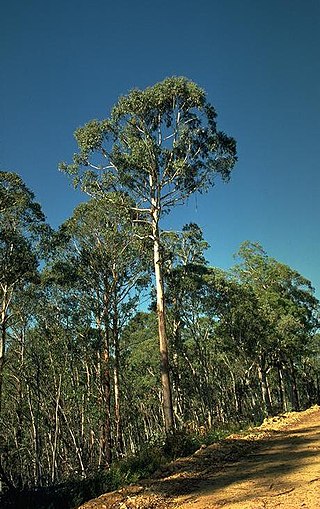
Eucalyptus delegatensis, commonly known as alpine ash, gum-topped stringybark, white-top and in Victoria as woollybutt, is a species of tree that is endemic to southeastern Australia. It has a straight trunk with rough, fibrous to stringy bark on the lower half of the trunk, smooth white bark above, lance-shaped to curved adult leaves, flower buds in groups of between seven and fifteen, white flowers and barrel-shaped or hemispherical fruit.
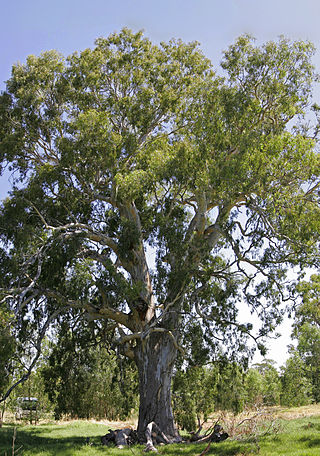
Eucalyptus camaldulensis, commonly known as the river red gum, is a species of flowering plant in the family Myrtaceae, and is endemic to Australia. It is a tree with smooth white or cream-coloured bark, lance-shaped or curved adult leaves, flower buds in groups of seven or nine, white flowers and hemispherical fruit with the valves extending beyond the rim. A familiar and iconic tree, it is seen along many watercourses across inland Australia, providing shade in the extreme temperatures of central Australia.
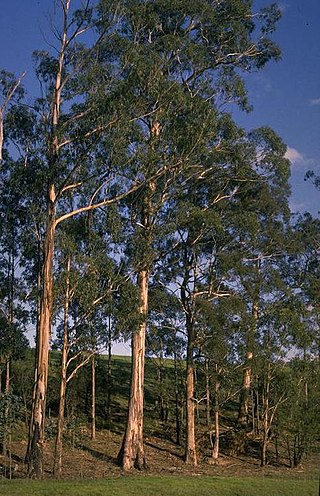
Eucalyptus globulus, commonly known as southern blue gum or blue gum, is a species of flowering plant in the family Myrtaceae. It is a tall, evergreen tree endemic to southeastern Australia. This Eucalyptus species has mostly smooth bark, juvenile leaves that are whitish and waxy on the lower surface, glossy green, lance-shaped adult leaves, glaucous, ribbed flower buds arranged singly or in groups of three or seven in leaf axils, white flowers and woody fruit.
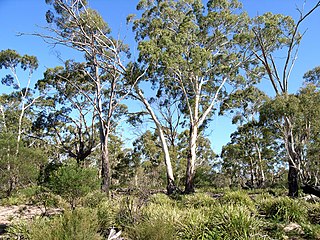
Eucalyptus viminalis, commonly known as the manna gum, white gum or ribbon gum, is a species of small to very tall tree that is endemic to south-eastern Australia. It has smooth bark, sometimes with rough bark near the base, lance-shaped to curved adult leaves, flower buds in groups of three or seven, white flowers and cup-shaped or hemispherical fruit.

Eucalyptus dalrympleana, commonly known as mountain gum, mountain white gum, white gum and broad-leaved ribbon gum, is a species of tree that is endemic to southeastern Australia. It has smooth bark, lance-shaped adult leaves, flower buds in groups of three or seven, white flowers and cup-shaped, bell-shaped or hemispherical fruit.

Eucalyptus gunnii, commonly known as cider gum, is a species of large tree in the flowering plant family Myrtaceae. It is endemic to the island of Tasmania, Australia. It has mostly smooth bark, lance-shaped to egg-shaped adult leaves, flower buds in groups of three, white flowers and cylindrical to barrel-shaped fruit.

Eucalyptus radiata, commonly known as the narrow-leaved peppermint or Forth River peppermint, is a species of tree that is endemic to south-eastern Australia. It has rough, fibrous to flaky bark on the trunk and larger branches, smooth grey bark on the thinner branches, lance-shaped to curved or almost linear leaves, flower buds in groups of eleven to twenty or more, white flowers and cup-shaped, hemispherical or shortened spherical fruit.
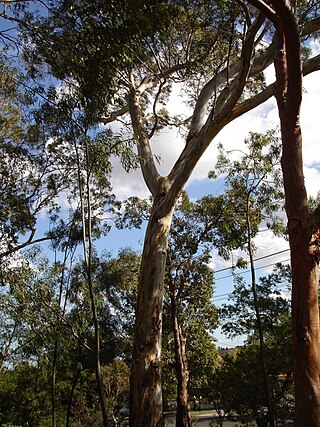
Eucalyptus leucoxylon, commonly known as yellow gum, blue gum or white ironbark, is a species of small to medium-sized tree that is endemic to south-eastern continental Australia. It has smooth yellowish bark with some rough bark near the base, lance-shaped or curved adult leaves, flower buds in groups of three and cylindrical, barrel-shaped or shortened spherical fruit. A widely cultivated species, it has white, red or pink flowers.

Eucalyptus rubida, commonly known as candlebark, ribbon gum or white gum, is a species of small to medium-sized tree that is endemic to south-eastern Australia. It has smooth bark, sometimes with rough bark at the base, lance-shaped or curved adult leaves, flower buds in groups of three, white flowers and cup-shaped, hemispherical or bell-shaped fruit.
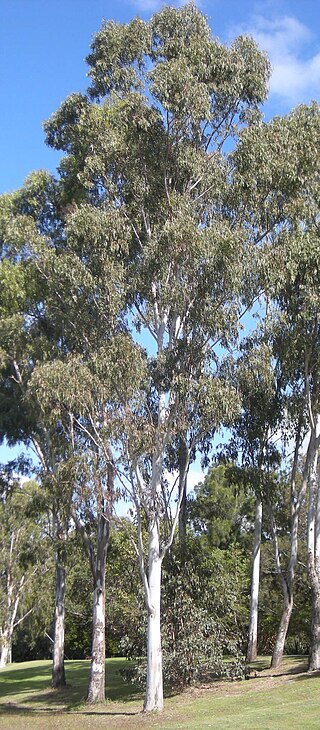
Eucalyptus tereticornis, commonly known as forest red gum, blue gum or red irongum, is a species of tree that is native to eastern Australia and southern New Guinea. It has smooth bark, lance-shaped to curved adult leaves, flower buds in groups of seven, nine or eleven, white flowers and hemispherical fruit.

Eucalyptus globulus subsp. bicostata, commonly known as the southern blue gum, eurabbie, blue gum or Victorian blue gum, is a subspecies of tree that is endemic to south-eastern Australia. It has mostly smooth bark with some persistent slabs of old bark at the base, juvenile leaves with one glaucous side, glossy, lance-shaped adult leaves, warty flower buds in groups of three, white flowers and hemispherical to conical fruit.

Eucalyptus mannifera, commonly known as the brittle gum or red spotted gum, is a species of small to medium-sized tree that is endemic to south-eastern Australia. It has smooth, powdery white bark, lance-shaped to curved adult leaves, flower buds in groups of seven, white flowers and cup-shaped, hemispherical or conical fruit.

Eucalyptus eugenioides, commonly known as the thin-leaved stringybark or white stringybark, is a species of tree endemic to eastern Australia. It is a small to medium-sized tree with rough stringy bark, lance-shaped to curved adult leaves, Flower buds in groups of between nine and fifteen, white flowers and hemispherical fruit.

Eucalyptus globulus subsp. globulus, commonly known as the Tasmanian blue gum, southern blue gum, or blue gum, is a subspecies of tree that is endemic to southeastern Australia. It has mostly smooth bark with some persistent slabs of old bark at the base, juvenile leaves with one glaucous side, glossy, lance-shaped adult leaves, warty flower buds arranged singly in leaf axils, white flowers and hemispherical to conical fruit that is more or less square in cross-section.
Eucalyptus pauciflora subsp. acerina, commonly known as snow gum, is a mallee or small tree that is endemic to a small area of Victoria, Australia. It has smooth, shiny bark, glossy green lance-shaped to egg-shaped leaves, flower buds in groups of between nine and fifteen, white flowers and hemispherical or conical fruit. It differs from other subspecies of E. pauciflora in having a dense crown and no parts that are glaucous.
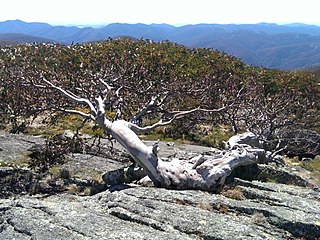
Eucalyptus pauciflora subsp. debeuzevillei, commonly known as Jounama snow gum, is a mallee or small tree that is native to a few mountain peaks in south-eastern Australia. It has smooth, shiny bark, glossy green lance-shaped to egg-shaped leaves, flower buds in groups of between nine and fifteen, white flowers and hemispherical or conical fruit. It differs from other subspecies of E. pauciflora in having angular flower buds.
Eucalyptus pauciflora subsp. hedraia, commonly known as snow gum, is a mallee or small tree that is endemic to a small area of Victoria, Australia. It has smooth bark, branchlets that are often glaucous, glossy green lance-shaped to egg-shaped or elliptical adult leaves, flower buds in groups of between eleven and fifteen, white flowers and hemispherical or cup-shaped fruit. It differs from other subspecies of E. pauciflora in having larger, sessile, glaucous buds and broader, hemispherical fruit.
Eucalyptus pauciflora subsp. parvifructa is a mallee or small tree that is endemic to a small area of Victoria, Australia. It has smooth bark, slightly glaucous branchlets, glossy green, lance-shaped adult leaves, flower buds usually in groups of seven, white flowers and hemispherical or cup-shaped fruit. It differs from other subspecies of E. pauciflora in having a smaller habit and smaller leaves, flower buds and fruit.

Eucalyptus pauciflora subsp. niphophila, commonly known as snow gum, is a small tree or large shrub that is native to a few mountain peaks in eastern Australia. It has smooth bark, glossy green, lance-shaped to egg-shaped or elliptical leaves, flower buds in groups of between nine and fifteen, white flowers and cup-shaped, hemispherical or conical fruit. It differs from other subspecies of E. pauciflora in having more delicate, pedicellate flower buds and smaller leaves.

Eucalyptus pauciflora subsp. pauciflora, commonly known as snow gum, cabbage gum or white sally is a tree or mallee that is endemic to eastern Australia. It has smooth bark, glossy green, lance-shaped, curved or elliptical leaves, flower buds in groups of between nine and fifteen, white flowers and cup-shaped, hemispherical or conical fruit.






















